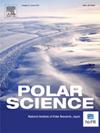Spatial and temporal occurrence of two Gyrodinium species in the seasonal ice zone off Wilkes Land, Southern Ocean
IF 2
4区 地球科学
Q3 ECOLOGY
引用次数: 0
Abstract
Sea ice is crucial for regulating primary production and carbon export. Among sea ice-dwelling organisms, the genus Gyrodinium (Dinophyceae) are particularly significant, with their release into the water column influencing carbon flow in the lower food web. Specifically, G. rubrum and G. heterogrammum feed on phytoplankton and may contribute to carbon export, as their cells resemble fecal pellets. However, due to the challenges in quantifying Gyrodinium cells microscopically, the species-specific dynamics of these organisms remained unclear in the seasonal ice zone of the Southern Ocean. This study investigates the abundance of G. rubrum and G. heterogrammum in sea ice, seawater, and sinking particles using quantitative PCR analysis. Our results indicate that G. rubrum is widely distributed from coastal polynyas to continental slopes, whereas G. heterogrammum is confined to coastal areas. Sediment trap data showed G. rubrum flux at 60 m depth increased with sea ice melting. In contrast, G. heterogrammum fluxes at depths of 150 and 500 m were observed more frequently than those of G. rubrum, with no apparent correlation to sea ice melting. These findings suggest that G. rubrum distribution is closely linked to sea ice melt, whereas G. heterogrammum appears to be unaffected by such changes.
南大洋威尔克斯陆附近季节性冰区两种 Gyrodinium 的时空分布情况
海冰对于调节初级生产和碳出口至关重要。在海冰生物中,陀螺藻属(Dinophyceae)尤为重要,它们释放到水柱中影响下层食物网的碳流。具体来说,G. rubrum和G. heterogramum以浮游植物为食,可能有助于碳输出,因为它们的细胞类似于粪便颗粒。然而,由于在显微镜下定量Gyrodinium细胞的挑战,这些生物在南大洋季节性冰带中的物种特异性动态尚不清楚。本研究采用定量PCR的方法,研究了海冰、海水和下沉颗粒中红藻和异藻的丰度。结果表明,红草属植物广泛分布于沿海多礁滩至大陆斜坡,而异草属植物仅局限于沿海地区。沉积物捕集器数据显示,60 m深度的G. rubrum通量随着海冰融化而增加。相比之下,在150和500 m深度观测到的异叶藻通量比红叶藻更频繁,与海冰融化没有明显的相关性。这些发现表明,红毛藻的分布与海冰融化密切相关,而异毛藻似乎不受这种变化的影响。
本文章由计算机程序翻译,如有差异,请以英文原文为准。
求助全文
约1分钟内获得全文
求助全文
来源期刊

Polar Science
ECOLOGY-GEOSCIENCES, MULTIDISCIPLINARY
CiteScore
3.90
自引率
5.60%
发文量
46
期刊介绍:
Polar Science is an international, peer-reviewed quarterly journal. It is dedicated to publishing original research articles for sciences relating to the polar regions of the Earth and other planets. Polar Science aims to cover 15 disciplines which are listed below; they cover most aspects of physical sciences, geosciences and life sciences, together with engineering and social sciences. Articles should attract the interest of broad polar science communities, and not be limited to the interests of those who work under specific research subjects. Polar Science also has an Open Archive whereby published articles are made freely available from ScienceDirect after an embargo period of 24 months from the date of publication.
- Space and upper atmosphere physics
- Atmospheric science/climatology
- Glaciology
- Oceanography/sea ice studies
- Geology/petrology
- Solid earth geophysics/seismology
- Marine Earth science
- Geomorphology/Cenozoic-Quaternary geology
- Meteoritics
- Terrestrial biology
- Marine biology
- Animal ecology
- Environment
- Polar Engineering
- Humanities and social sciences.
 求助内容:
求助内容: 应助结果提醒方式:
应助结果提醒方式:


